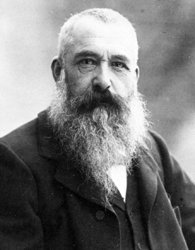French painter Claude Monet was the central figure of the Impressionist movement in the late 19th century, producing colorful, vibrant studies of natural and architectural landscapes.
Claudet Monet’s Early Years
Oscar-Claude Monet was born in Paris on November 14, 1840. His family moved to Le Havre soon after his birth. Monet’s parents were comfortable financially, giving the young Monet an opportunity to pursue art. By the time he was a teenager, Monet was selling his charcoal drawings and caricatures to local residents. The greatest influence on Monet’s artwork during this time appeared in 1858, when Monet met landscape painter Eugene Boudin. Boudin ran an art supply store in Le Havre, and he soon convinced Monet to join him for some outdoor painting, a subject that would become central to Monet’s later work.
In 1859, Monet moved back to Paris to study painting at the Suisse Academy. During this period, Monet became friends with painter Camille Pissarro. After only a short time at the Academy, Monet put his painting on hold to join the First Regiment of African Light Cavalry. Monet spent the next two years serving in Algeria, but was allowed to return to France early after he contracted typhoid. Monet was deeply influenced by the bright colors of African scenery, as can be seen in his subsequent paintings. After his military service was cut short, Monet returned to Le Havre where he worked with Boudin and Dutch landscape painter Johan Bartold Jongkind. In 1862, Monet went back to Paris and joined the studio of Charles Gleyre, where Monet met artists Frederic Bazille, Alfred Sisley and Pierre-Auguste Renoir.
Sources in this Story
- Biography.com: The Impressionists: Claude Monet
- The Impressionist Movement and Its Greatest Painters: Claude Monet
- The Guggenheim Museum: Claude Monet Biography
- The Metropolitan Museum: Heilbrunn Timeline of Art History: Claude Monet (1840–1926)
- St. Petersburg Times: Monet’s London
- Claude Monet Life and Art: Claude Monet in Venice
Monet’s Notable Accomplishments
Monet exhibited several paintings at the Salon art show in Paris, but financial difficulties forced him back to Le Havre in 1867. In 1870, he was able to return to Paris, where he married Camille-Léonie Doncieux. That same year, the couple moved to London to escape the Franco-Prussian War. In the first half of the 1870s, Monet and his group of artists, known as Société Anonyme des Artistes, began developing a clear style. Monet exhibited his painting “Impression, Sunrise” (1872) at the group’s first show. An art journalist insultingly referred to Monet and his colleagues as “impressionists,” and the group adopted the newly coined name. In spite of a rocky private life, Monet continued to paint, regularly exhibiting paintings with his Impressionist group. In the 1880s, Monet’s solo shows attracted more and more attention, and with the attention came financial stability.
In 1890, Monet, now recognized as the leader of the Impressionist movement, bought an estate in Giverny, France. Monet designed the garden himself; it featured willow trees, Japanese-style bridges and a vast lily pond, and would serve as his muse for many years. During the 1890s, Monet produced such popular landscape series as “Haystacks” (1891), “Poplars” (1892) and “Rouen Cathedral” (1894).
Beginning in 1906, Monet spent most of his time painting his garden in Giverny, making vibrant studies of the lily pond. He did occasionally travel outside of France, to London to paint the Thames River and to Venice to paint the canals.
The Man and his Work
- “Monet in the 20th Century” by Paul Hayes Tucker
- “Claude Monet, 1840–1926” by Christoph Heinrich
- “Monet” by Robert Gordon
- “The Unknown Monet: Pastels and Drawings” by James A. Ganz
- “Monet’s Table: The Cooking Journals of Claude Monet” by Claire Joyes
The Rest of the Story
Monet’s second wife, Alice Hoschedé, died in 1911, and for the remainder of his life, Monet was occupied with his Giverny garden. Monet continued a series of large-scale, mural-size paintings of the garden up until his death on December 5, 1926. The garden paintings were later displayed in the specially designed Paris Orangerie gallery. Subsequent exhibitions and analyses have established Monet as one of the most important and influential Western painters in art history.
This article was originally written by Caleb March; it was updated November 14, 2017.











